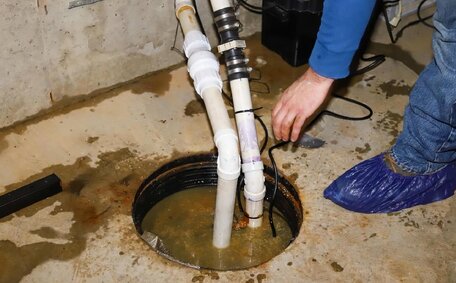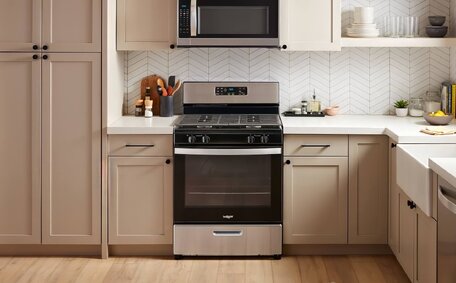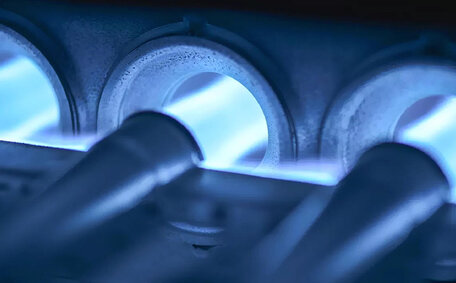Understanding Common Toilet Noises
When it comes to toilet noises, there are several common toilet sounds that can indicate potential plumbing issues. A toilet can often make a symphony of sounds, all with its own unique reasons:
Hissing or Gurgling
A hissing or gurgling in your toilet often indicates water flow complications or air entrapment in the system and may suggest leaks, flapper valve obstruction, or fill valve malfunctions leading to excess water in the tank.
Knocking or Banging
A banging or knocking sound often points to water hammer, occurring when water flow stops suddenly, creating pressure waves in the pipes. Installing water hammer arrestors can effectively mitigate banging sounds, and is a recommended preventive measure.
Running Water
If you hear continuous running water, it’s likely a faulty flapper valve that’s not sealing correctly. Understanding how to fix these issues becomes essential when your toilet is facing such problems.
High-Pitched Whistling
A whistling tone that sounds like wind whistling through a narrow space, often points to an issue with the fill valve not closing fully. This allows water to leak through, creating that hissing sound. Adjusting or replacing the fill valve to regulate water flow into the tank should resolve the issue.
Identifying the specific sounds from your toilet is crucial for pinpointing the root causes and addressing these common plumbing issues.
Fill Valve Issues
The toilet fill valve, also known as the ballcock assembly, is the mechanism that governs toilet water tank refilling with fresh water after a flush cycle. A functioning fill valve should shut off the water supply after reaching the designated water level in the tank. However, a faulty fill valve can result in numerous toilet problems,
Symptoms of Fill Valve Issues
A persistent hissing noise post-flushing often signifies fill valve issues. This indicates the valve isn’t closing properly, causing the tank to overfill. Other indicators of your toilet water problems include:
- Water level in your toilet tank too high or overflowing after flush
- Your toilet keeps making the noise of continually running/filling with water without pause
- High water bills, leaving you wondering how much water wasted every few minutes
Troubleshooting Fill Valve Problems
Diagnosing fill valve issues when the toilet is not in use prioritises safety. To begin repairs, turn off water to the toilet and flush to empty the tank. Then, inspect the bottom tank and these common trouble spots:
- Inspect the float ball - Is it adjusted to the proper height? Is it damaged?
- Examine the tank water level - Is it too high and spilling into the overflow tube?
- Test the valve seal - Does the fill valve seal tightly when water flow stops?
- Check for debris blocking valve operation
Your troubleshooting may reveal that parts need cleaning or adjusting. However, you’ll likely need to replace the entire fill valve to fully correct the problem. Installing a new fill valve with an anti-syphon design can also lessen your worry about future issues.
Periodic inspections of the toilet’s fill valve can prevent potential plumbing problems.
Faulty or Outdated Components
Over time, the various mechanical parts inside your toilet tank can wear out or break entirely. Noisy toilets often result from worn or damaged components like flapper valves, flush valves, tank lids, and handles.
Signs of Problem Parts
Visible damage such as cracks or leaks signals a running toilet. Mineral-clogged flush valves may not fully open, causing suboptimal and noisy flushes.
Even visually undamaged parts can cause undesired toilet noise, prompting questions on how to resolve the issue. A faulty flapper valve that seals inadequately often will make noise when the toilet is used, echoing with running water sounds. Loose tank lid fittings can create banging noises when the tank refills.
Replacing Toilet Components
Upon finding damaged or faulty components, replacing them is the clear solution. Thankfully, most toilet components are inexpensive and easy to swap out yourself. When buying new parts, look for improved models like dual-flush flappers or push-button metal flush valves to save water and prevent future issues.
Replacing old or faulty toilet components can restore efficient and silent operation. And stopping unnecessary water waste protects both your plumbing system and your water bill.
Drain Line Blockages
Gurgling sounds may arise from drain line obstructions. Over time, drain lines can become clogged with accumulated debris, grease, hair, and mineral deposits.
Signs of a Drain Line Clog
Symptoms that may indicate a drain line blockage include:
- Gurgling sound when water enters into bowl during a flush
- Toilet backing up and draining slowly
- Foul sewage odours coming from toilet
- Wet spots around base of toilet
Clearing Minor Drain Clogs
For minor clogs, using a closet auger to feed a flexible rod into the bowl can dislodge blockages. A drain snake can also help remove obstructions. Always be very careful not to scratch or damage the drain pipes when attempting to clear clogs.
For severe or persistent clogs making your toilet fussy, consider professional plumbing services that use high-pressure water jetting for a complete clear. Getting to the root of drain line issues can save you from major blocked drain headaches down the road.
Water Pressure Problems
Improper water pressure can lead to loud vibrations and noises in your toilet and plumbing. If the water pressure entering your home is too high, it can create loud banging sounds known as "water hammer." Water hammer occurs when quick-closing valves halt water flow suddenly, sending shock waves through the pipes.
Adjusting Water Pressure
Alleviating water hammer can be achieved by regulating your home’s main shut-off valve. Gradually turn the valve all way to counteract water pressure until the banging noises cease. Just take care not to restrict water flow too much or your plumbing fixtures may have trouble functioning properly.
Installing Water Hammer Arrestors
Besides lowering water pressure, installing water hammer arrestors offers a reliable solution, particularly in homes with frequent water use. These devices, similar to the way tankless water systems function, contain air chambers that provide a cushion to dampen pressure surges. Water hammer arrestors easily install onto your home’s water line and enhance the durability of your plumbing system.
Getting your home’s water pressure regulated can answer the question of why your toilet is creating disruptive noises and also help in protecting your plumbing. In case assistance is necessary, give us a ring with confidence, and a skilled plumber can evaluate your concerns providing appropriate solutions.
DIY Repairs
Addressing minor toilet issues with DIY solutions can be cost-effective, negating the need for a professional plumber.
Replace the Flapper
You can easily replace an aged or leaking toilet flapper valve. Adjust as needed to create a proper seal in your tank.
First you’ll want to make the smart move to turn off the water at the supply valve, effectively stopping any issues that could cause water flow, and flush to empty the tank. Remove the old flapper then fit an identical new one, ensuring the flapper chain has ample slack.
Troubleshoot the Fill Valve
Make sure that toilet fill water level is set appropriately and refill tube is unblocked. Remove any debris obstructing the fill valve. Ensure the float cup or ball operates freely to close valve once tank filled. Replace fill valve if damaged.
Inspect the Flush Valve
Mineral buildup around the flush valve can impede full opening. Use a small wire brush to carefully scrub deposits away, enabling complete valve lift when flushing. Take safety precautions and work slowly to avoid scratches.
Tackling basic toilet repairs yourself using manufacturer instructions and hardware store replacement parts can resolve common issues and cut costs.
When to Call a Professional Plumber
While minor toilet repairs can often be handled as DIY projects, there are some situations where it’s best to call in a professional plumber:
Persistent Noises
If tweaking or substituting parts does not halt the problematic noises from your toilet, this hints at an underlying glitch that calls for a licensed plumber’s expertise. Persistent banging from water hammer or gurgling from a stubborn drain blockage should be addressed by a licenced plumber.
Large-Scale Problems
Significant visible damage, severe clogs, major leaks, or flooding point to complex problems within your plumbing system. Attempting extensive repairs without proper training can risk making the issues much worse.
Unsure Diagnosis
You know your home best. If unsure about the exact cause of your toilet’s noises, don’t guess - figure out the problem with a professional. This avoids improper repairs that lead to costly errors down the road.
For trustworthy assistance to diagnose fix stubborn toilet noise, contact the licenced professionals at Paddington Plumbing. Call 1300 349 338 or email [email protected] to schedule service.
Preventative Maintenance
Consistent inspection and maintenance can avert expensive future toilet repairs. Replace damaged or leaky components. Carefully scrub away calcium deposits before they block water flow.
Every 6 months, check internal parts like the flapper, fill valve, and flush valve for wear, mineral buildup, and proper function.
Also examine the refill tube and overflow pipe to ensure no obstructions. Clean the toilet bowl thoroughly to stop gunk accumulation. Using a tank cleaning tablet occasionally can help descale tank internals.
Basic maintenance extends the system’s lifespan by catching issues early, preventing bigger problems. For homes in Paddington’s hard water area, vigilant upkeep guards against scale forming in pipes and noisy fill valves shutting off improperly.






